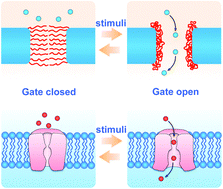Stimuli-responsive smart gating membranes†
Abstract
Membranes are playing paramount roles in the sustainable development of myriad fields such as energy, environmental and resource management, and human health. However, the unalterable pore size and surface properties of traditional porous membranes restrict their efficient applications. The performances of traditional membranes will be weakened upon unavoidable membrane fouling, and they cannot be applied to cases where self-regulated permeability and selectivity are required. Inspired by natural cell membranes with stimuli-responsive channels, artificial stimuli-responsive smart gating membranes are developed by chemically/physically incorporating stimuli-responsive materials as functional gates into traditional porous membranes, to provide advanced functions and enhanced performances for breaking the bottlenecks of traditional membrane technologies. Smart gating membranes, integrating the advantages of traditional porous membrane substrates and smart functional gates, can self-regulate their permeability and selectivity via the flexible adjustment of pore sizes and surface properties based on the “open/close” switch of the smart gates in response to environmental stimuli. This tutorial review summarizes the recent developments in stimuli-responsive smart gating membranes, including the design strategies and the fabrication strategies that are based on the introduction of the stimuli-responsive gates after or during membrane formation, and the positively and negatively responsive gating models of versatile stimuli-responsive smart gating membranes, as well as the advanced applications of smart gating membranes for regulating substance concentration in reactors, controlling the release rate of drugs, separating active molecules based on size or affinity, and the self-cleaning of membrane surfaces. With self-regulated membrane performances, smart gating membranes show great power for use in global sustainable development.


 Please wait while we load your content...
Please wait while we load your content...